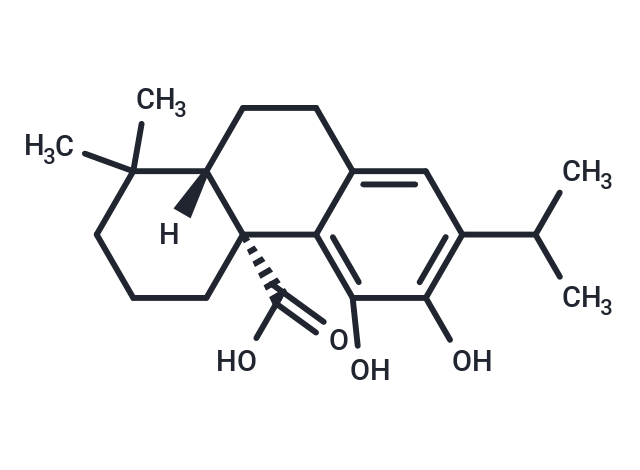Shopping Cart
- Remove All
 Your shopping cart is currently empty
Your shopping cart is currently empty

Carnosic acid is a lipid absorption inhibitor, endowed with antioxidative, antimicrobial, photoprotective potential, and antiproliferative properties.

| Pack Size | Price | Availability | Quantity |
|---|---|---|---|
| 10 mg | $40 | In Stock | |
| 25 mg | $74 | In Stock | |
| 50 mg | $123 | In Stock | |
| 100 mg | $179 | In Stock | |
| 500 mg | $453 | In Stock | |
| 1 mL x 10 mM (in DMSO) | $39 | In Stock |
| Description | Carnosic acid is a lipid absorption inhibitor, endowed with antioxidative, antimicrobial, photoprotective potential, and antiproliferative properties. |
| In vitro | ARPE-19 cells were pre-treated with 10 μM carnosic acid for 24 h followed by treatment with acrylamide (0.7 or 1 mM) for 24 h. ARPE-19 cells pre-treated with 10 μM carnosic acid showed significantly increased cell viability and decreased cell death rate when compared to ARPE-19 cells treated with acrylamide alone [1]. A pretreatment of human neuroblastoma SH-SY5Y cells with carnosic acid at 1 μM for 12 h prevented the hydrogen peroxide (H2O2)-induced impairment of the TCA enzymes (aconitase, α-ketoglutarate dehydrogenase (α-KGDH), succinate dehydrogenase (SDH)) and abolished the inhibition of the complexes I and V and restored the levels of ATP by a mechanism associated with Nrf2 [2]. |
| In vivo | Carnosic acid significantly down-regulated fasting blood glucose, glucose level in oral glucose tolerance test (OGTT) and insulin tolerance test (ITT), ameliorated CIA-induced bone loss, and reduced pro-inflammatory cytokines and reactive oxygen species (ROS) in db/db mice with arthritis induced by CIA [3]. |
| Cell Research | Human dopaminergic neuroblastoma SH-SY5Y cells were cultured in Dulbecco's modified Eagle's medium (DMEM)/F-12 HAM nutrient medium (1:1 mixture; supplemented with 10% fetal bovine serum (FBS), 2 mM L-glutamine, penicillin (1000 units/mL), streptomycin (1000 μg/mL), and amphotericin B (2.5 μg/mL)) in a 5% CO2 humidified incubator at 37 °C. SH-SY5Y cells were cultured until a confluence of 80–90% was achieved and then trypsinized. H2O2 was utilized at 300 μM for different periods of incubation according to each specific assay. A pretreatment with CA (dissolved in DMSO) at 1 μM for 12 h was performed in order to test the ability of this diterpene in preventing the deleterious effects triggered by H2O2 in SH-SY5Y cells [2]. |
| Animal Research | Male C57BL/KsJ-db/db mice were given an intradermal injection of 100 μg of chicken type II collagen emulsified in complete Freund's adjuvant (1:1, w/v) into the base of the tail. 18 days after primary immunization, all mice showed signs of arthritis, and a booster, which consisted of 100 μg of chicken type II collagen emulsified in incomplete Freund's adjuvant (IFA; 1:1, v/v), was injected intradermally. All mice were divided into 7 groups; normal (Nor), db/db, db/db/CIA, and db/db/CIA with CA treatment. To investigate the effects of Carnosic acid (CA) on the development of arthritis, db/db mice and db/db/CIA mice were treated with 30 mg/kg body weight CA (CAL) and 60 mg/kg body weight CA (CAH) seven times per week for 4 weeks intraperitoneally after the booster injection. CA was prepared as 10 mmol/L stock solutions in DMSO [3]. |
| Molecular Weight | 332.43 |
| Formula | C20H28O4 |
| Cas No. | 3650-09-7 |
| Smiles | C(O)(=O)[C@@]12C=3C(=CC(C(C)C)=C(O)C3O)CC[C@]1(C(C)(C)CCC2)[H] |
| Relative Density. | 1.184 g/cm3 |
| Storage | keep away from direct sunlight,keep away from moisture | Powder: -20°C for 3 years | In solvent: -80°C for 1 year | Shipping with blue ice. | |||||||||||||||||||||||||||||||||||
| Solubility Information | DMSO: 100 mg/mL (300.82 mM), Sonication is recommended. H2O: Insoluble | |||||||||||||||||||||||||||||||||||
Solution Preparation Table | ||||||||||||||||||||||||||||||||||||
DMSO
| ||||||||||||||||||||||||||||||||||||

Copyright © 2015-2025 TargetMol Chemicals Inc. All Rights Reserved.